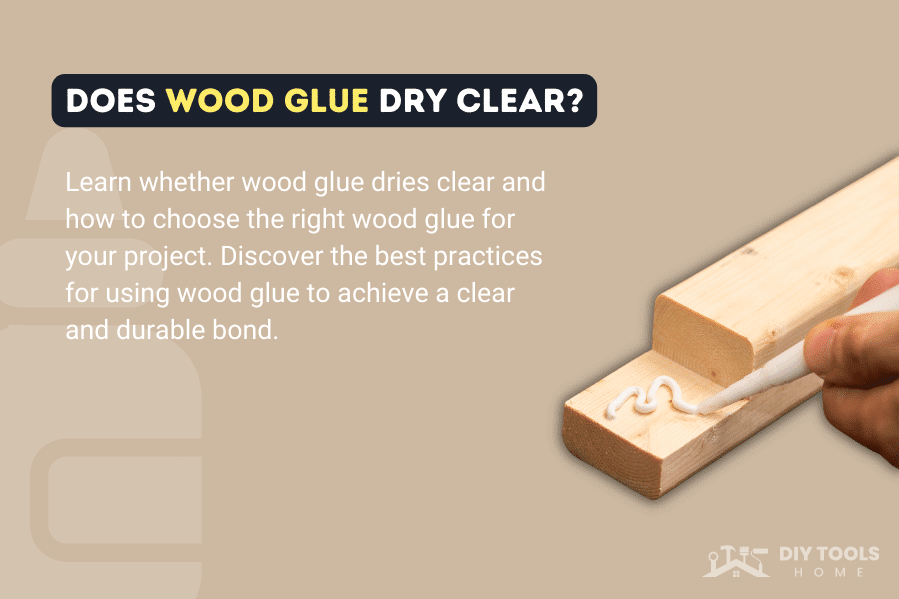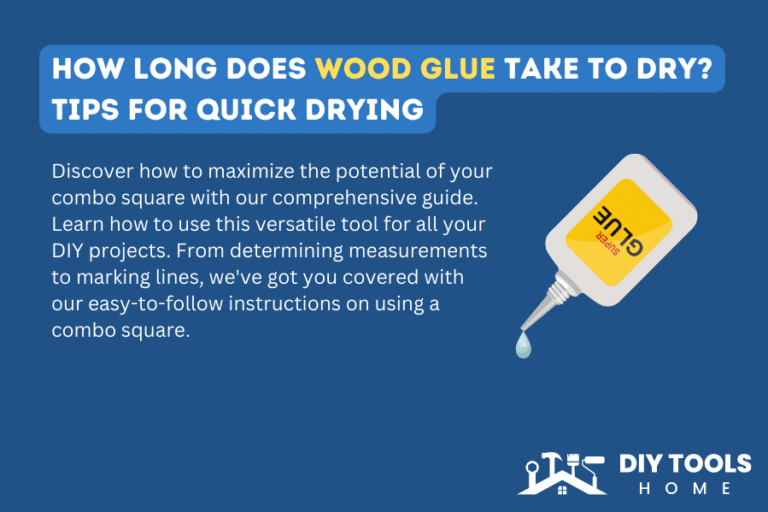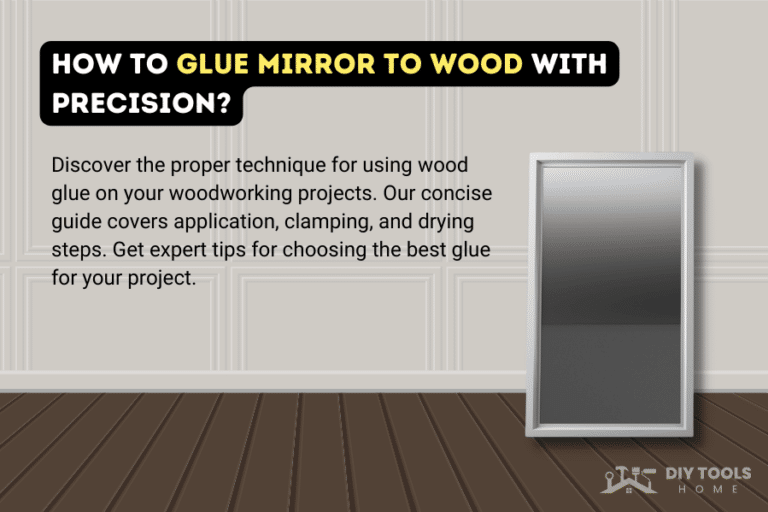Does Wood Glue Dry Clear?

Wood glue is a popular choice due to its ability to penetrate and bond with the fibers of the wood, creating a secure hold. However, one common question when using wood glue is whether it dries clear. It is an important consideration, especially if the project involves visible glue lines or the wood needs to be stained or painted.
Glue lines or residue can ruin the appearance of your project. Nobody wants to see globs of glue oozing out from between their nicely sanded and stained pieces of wood. Plus, if you’re painting or staining your project, any visible glue will make it challenging to achieve a smooth and even finish.
In this article, we will explore the answer to the question does wood glue dry clear? And provide all the information you need to make the best choice for your woodworking project.
Table of Contents
Types of Wood glue

Various types of wood glue are available in the market, each with distinct properties and drying characteristics.
1. PVA (Polyvinyl Acetate)
If you’re a DIY enthusiast, you’ve probably worked with PVA before; it’s the most common type of wood glue. It is a synthetic rubber, and PVA glue doesn’t release harmful fumes, making it an excellent choice for indoor projects. Additionally, it is non-flammable, so it reduces the risk of accidents in the workplace or at home. PVA glues have two variations: White dries to a translucent finish and is suitable for interior projects. Yellow may have a slightly yellow or tan tint with improved water resistance.
2. Cyanoacrylate glue
Cyanoacrylate glue is known as “Super Glue” or “Krazy Glue.” It is seriously powerful with quick-bonding capabilities, allowing it to combine materials like metal or plastic. It’s incredible how this adhesive can work its magic to fix just about anything. The thin version of this adhesive dries to a transparent finish, while the thicker version has cloudy color.
3. Polyurethane glue
Polyurethane glue is a type of plastic known for its durability and flexibility. What sets polyurethane glue apart from other types is that it is activated by moisture. Applying the glue to a surface will foam up and expand as it reacts with the moisture in the air. The foaming action of polyurethane glue makes it great for filling gaps and cracks. Polyurethane glue typically dries to a brown or amber color, but the exact shade of the glue can vary depending on the brand and formulation.
4. Epoxy glue
Epoxy glue is a type of adhesive known for its strong bonding properties. It is made up of two parts: the resin and the hardener. When these two parts are mixed, they create a chemical reaction resulting in a solid and durable bond. Epoxy glue can be used to bond a variety of materials, including metal, wood, plastic, and glass. Although epoxy glue is relatively expensive compared to other types of adhesives. And it dries to a clear or yellowish bond but can change color over time.
If you want to explore how long Wood Glue Take To Dry? Check it out!
Comparing Wood Glue Types: Do They Dry Clear?
Let’s further compare different wood glue types and explore whether they dry clear.
| Glue Name | Type | Does it dry clear? |
|---|---|---|
| Gorilla Wood Glue | PVA | Dries to a natural translucent tan color |
| Gorilla Ultimate Waterproof Wood Glue | PVA | No, it dries to a yellow color |
| Titebond Original | White PVA | No, dries to a yellow color |
| Titebond II | Yellow PVA with polyisocyanate | No, it dries to an orange color |
| Titebond III | PVA and polyurethane | No, it dries to a brown color |
| Elmer’s Carpenter’s Wood Glue | White PVA | No, it dries to a light brown color |
| J-B Weld WoodWeld Epoxy | Epoxy | Dries to a light tan color |
| Weldwood Original Wood Glue | PVA | Dries to a translucent or light yellow color |
| Evo-Stik Interior | PVA | Translucent or light yellow color |
Tips for Achieving a Clear Finish with Wood Glue
It can be hard to find clear wood glue, but here are tips and tricks to remove glue from the
wood and achieve a clear finish with regular wood glue.
- Apply thin layers of glue: Applying thin, even layers of glue to ensure a smooth and precise finish is essential when working with wood glue to achieve a transparent look. Thick layers of glue can create a cloudy or hazy appearance, which can be difficult to remove. Applying multiple thin layers can help to achieve a transparent finish while allowing each layer to dry properly.
- Remove Excess glue: After applying the glue, clean up any excess glue that squeezes out of the joint. This can be done with a damp paper towel or cloth while the glue is still wet. This step is crucial for achieving a clean and transparent finish.
- Sanding & Scraping: Once the glue has dried, any excess glue not removed during the cleaning step can be removed by sanding or scraping it. Be gentle during this step to avoid damaging the surrounding wood.
- Apply a Clear coat of Varnish: A clear coat or Varnish can be applied to the surface to enhance the transparent finish further after the glue has fully cured. It will protect the wood and provide a glossy finish. It’s essential to choose a clear coat or Varnish compatible with the type of glue used and follow the manufacturer’s instructions for application and drying times.
Conclusion
While finding wood glue that dries completely transparently can be challenging, there are still ways to achieve a clear and beautiful finish without relying on completely transparent glue. It’s always a good idea to test the wood glue on a scrap piece before applying it to your project. It will help you determine how the glue will dry and whether it will leave any residue or discoloration on the wood.
Following our tips, you can achieve a transparent finish with wood glue. You can still achieve a precise and beautiful finish on your woodworking projects with extra care and attention to detail.
FAQs
1. How does Gorilla wood glue dry?
Gorilla Wood Glue typically dries to a natural wood color, which is a pale yellowish color. Depending on the wood type, this color can blend in, but they have a variant called gorilla clear glue.
2. Can I use wood glue for projects where appearance matters?
When using wood glue for projects where appearance is essential, choose a wood glue that dries to a color that closely matches the wood you’re working with. Test the adhesive on a small, inconspicuous area before applying it to the entire project to ensure it dries with the desired appearance.
3. Which wood glues dry to a more transparent or natural finish?
Gorilla Wood Glue dries to a natural translucent tan color, while Titebond Translucent Wood Glue dries to a translucent finish. These options are suitable for projects where a more transparent or natural appearance is desired.
4. Does Titebond Ultimate III Dry Clear?
Titebond Ultimate is wood glue that dries to a translucent or amber color.






